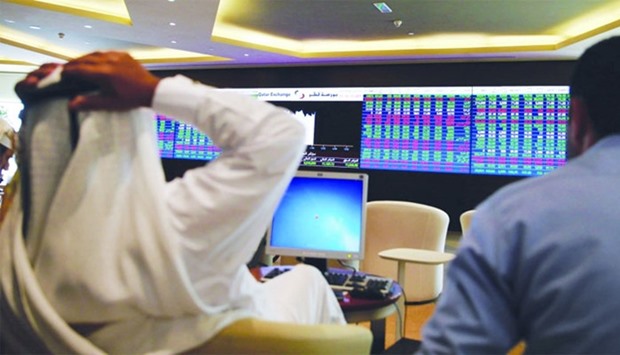The Qatar Stock Exchange on Tuesday plummeted more than 100 points in key index and about QR9bn in capitalisation, mainly dragged by real estate, telecom, banking and industrials sectors.
Foreign institutions turned net profit takers as the 20-stock Qatar Index settled 1.07% lower at two-month low of 10,010.24 points.
However, domestic institutions were increasingly bullish in the market, whose sensitive index registered 2.8% shrinkage year-to-date.
Market capitalisation eroded 1.49% to QR569.14bn mainly owing to large and midcap segments.
Islamic equities were seen declining slower than the main index in the market, where Gulf institutions turned marginally bullish.
Trade turnover and volumes were on the decline in the bourse, where industrials, banking and realty sectors together accounted for about 79% of the total volume.
The Total Return Index shed 0.99% to 17,944.45 points, Al Rayan Islamic Index (Price) by 0.8% to 2,373.12 points and All Share Index by 1.32% to 3,035.99 points.
The real estate index plummeted 2.21%, telecom (1.46%), banks and financial services (1.38%), industrials (1.25%), insurance (0.74%) and transport (0.67%); while consumer goods rose 0.04%.
More than 52% of the traded constituents were in the red with major shakers being Ezdan, Vodafone Qatar, Ooredoo, Industries Qatar, QNB, Qatari Investors Group, Aamal Company and Qatar Insurance; even as Salam International Investment, Qatari German Company for Medical Devices, Al Khaleej Takaful and Doha Bank were among the prime gainers.
Non-Qatari institutions turned net sellers to the tune of QR23.5mn against net buyers of QR1.6mn on Monday.
However, domestic funds’ net buying grew impressively to QR38.94mn compared to QR26.69mn the previous day.
The Gulf institutions were net buyers to the extent of QR1.02mn against net sellers of QR2.4mn on March 4.
Non-Qatari individuals’ net profit booking declined noticeably to QR2mn compared to QR8.46mn on Monday.
The Gulf individuals’ net selling weakened perceptibly to QR0.44mn against QR2.05mn the previous day.
Local retail investors’ net profit booking fell marginally to QR14.02mn compared to QR15.34mn on March 4.
Total trade volume fell 18% to 8.13mn shares, value by 13% to QR232.18mn and transactions by 18% to 5,372.
The real estate sector’s trade volume plummeted 41% to 1.12mn equities, value by 35% to QR19.32mn and deals by 44% to 712.
The industrials sector reported 22% plunge in trade volume to 3.77mn stocks, 4% in value to QR88.43mn and 19% in transactions to 2,127.
The telecom sector’s trade volume tanked 7% to 0.64mn shares and value by 22% to QR11.01mn, whereas deals grew 14% to 492.
The banks and financial services sector saw 6% decline in trade volume to 1.53mn equities, 26% in value to QR72.9mn and 15% in transactions to 1,205.
The transport sector’s trade volume was down 2% to 0.46mn stocks, while value grew 8% to QR10.65mn but on 8% fall in deals to 298.
However, there was 62% surge in the insurance sector’s trade volume to 0.42mn shares, 67% in value to QR13.96mn and 27% in transactions to 274.
The consumer goods sector’s trade volume grew 19% to 0.19mn equities, value by 16% to QR15.92mn and deals by 6% to 264.
In the debt market, there was no trading of treasury bills and sovereign bonds.
However, domestic institutions were increasingly bullish in the market, whose sensitive index registered 2.8% shrinkage year-to-date.
Market capitalisation eroded 1.49% to QR569.14bn mainly owing to large and midcap segments.
Islamic equities were seen declining slower than the main index in the market, where Gulf institutions turned marginally bullish.
Trade turnover and volumes were on the decline in the bourse, where industrials, banking and realty sectors together accounted for about 79% of the total volume.
The Total Return Index shed 0.99% to 17,944.45 points, Al Rayan Islamic Index (Price) by 0.8% to 2,373.12 points and All Share Index by 1.32% to 3,035.99 points.
The real estate index plummeted 2.21%, telecom (1.46%), banks and financial services (1.38%), industrials (1.25%), insurance (0.74%) and transport (0.67%); while consumer goods rose 0.04%.
More than 52% of the traded constituents were in the red with major shakers being Ezdan, Vodafone Qatar, Ooredoo, Industries Qatar, QNB, Qatari Investors Group, Aamal Company and Qatar Insurance; even as Salam International Investment, Qatari German Company for Medical Devices, Al Khaleej Takaful and Doha Bank were among the prime gainers.
Non-Qatari institutions turned net sellers to the tune of QR23.5mn against net buyers of QR1.6mn on Monday.
However, domestic funds’ net buying grew impressively to QR38.94mn compared to QR26.69mn the previous day.
The Gulf institutions were net buyers to the extent of QR1.02mn against net sellers of QR2.4mn on March 4.
Non-Qatari individuals’ net profit booking declined noticeably to QR2mn compared to QR8.46mn on Monday.
The Gulf individuals’ net selling weakened perceptibly to QR0.44mn against QR2.05mn the previous day.
Local retail investors’ net profit booking fell marginally to QR14.02mn compared to QR15.34mn on March 4.
Total trade volume fell 18% to 8.13mn shares, value by 13% to QR232.18mn and transactions by 18% to 5,372.
The real estate sector’s trade volume plummeted 41% to 1.12mn equities, value by 35% to QR19.32mn and deals by 44% to 712.
The industrials sector reported 22% plunge in trade volume to 3.77mn stocks, 4% in value to QR88.43mn and 19% in transactions to 2,127.
The telecom sector’s trade volume tanked 7% to 0.64mn shares and value by 22% to QR11.01mn, whereas deals grew 14% to 492.
The banks and financial services sector saw 6% decline in trade volume to 1.53mn equities, 26% in value to QR72.9mn and 15% in transactions to 1,205.
The transport sector’s trade volume was down 2% to 0.46mn stocks, while value grew 8% to QR10.65mn but on 8% fall in deals to 298.
However, there was 62% surge in the insurance sector’s trade volume to 0.42mn shares, 67% in value to QR13.96mn and 27% in transactions to 274.
The consumer goods sector’s trade volume grew 19% to 0.19mn equities, value by 16% to QR15.92mn and deals by 6% to 264.
In the debt market, there was no trading of treasury bills and sovereign bonds.


